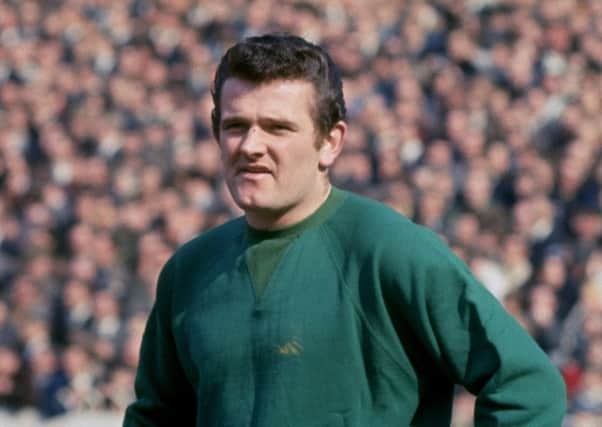Obituary: Tommy Lawrence, goalkeeping stalwart of Bill Shankly's great Liverpool side


Tommy Lawrence, who has died aged 77, was one-third of the all-Scottish backbone – with Ron Yeats and Ian St John – of the first great Liverpool side which Bill Shankly created in the early 1960s.
The stocky Lawrence, who at his peak weighed more than 14st, was affectionately dubbed “The Flying Pig” by the Anfield Koppites. Perhaps they were unaware how good Ayrshire bacon is, but they certainly knew how good a goalkeeper the big man from Dailly was.
Advertisement
Hide AdAdvertisement
Hide AdThe Lawrence family relocated from South Ayrshire to Warrington, but not before Tommy had developed a childhood affection for Ayr United.
After school at Warrington, he went to work in the local Rylands wire works, while continuing his football education with Warrington Town, from where manager Phil Taylor signed the 17-year-old for Liverpool in 1957.
Bill Shankly then replaced Taylor, but Lawrence still had to serve a lengthy apprenticeship, behind fellow Scots Tommy Younger and Bill Slater, before Shankly handed him his debut against West Brom at the Hawthorns in October 1962. That game, which Liverool lost 1-0, was the first of 390 first-team games Lawrence would play over the next eight years.
Having waited so long for his chance, Lawrence was seemingly unwilling to give up his place. In all he missed just six matches over the next eight years, as he backstopped Liverpool to the English League title in 1963-64, the FA Cup in 1964-65 and a second league title in 1965-66, plus a hat-trick of FA Charity Shield wins.
Being the best in England wasn’t good enough for Shankly, who craved European success, and Lawrence was a vital cog in the Liverpool team which, disposing of Celtic in the semi-final, reached the Hampden final of the European Cup-Winners Cup in 1966, losing 2-1 in extra time to Borussia Dortmund.
Lawrence perhaps owed his promotion to the first-team to Shankly’s liking for a big goalkeeper – the burly Lawrence was physically more imposing than Slater, whom he displaced. But he was also an innovator.
Having watched him playing in the fiercely-contested five-a-side matches at Liverpool’s Melwood training ground, Shankly encouraged Lawrence to leave his penalty area and sweep behind the defence, thus making him the first “sweeper-keeper”.
Lawrence later recalled how, when he first started venturing outfield: “The entire Kop, as one, was encouraging me to ‘get back in your box Tommy’.”
Advertisement
Hide AdAdvertisement
Hide AdHe had played a mere six first-team games when he was called up to the Scotland Under-23 team, which beat Wales 2-0 at Pittodrie, in December, 1962.
In June 1963, he earned the first of his eventual three full Scotland caps in a 1-0 end-of-season tour match against the Republic of Ireland, in Dublin.
Lawrence was then overlooked, until being recalled for the World Cup qualifier against West Germany, at Hampden in April 1969, which ended 1-1.
He held his place for Scotland’s next match, the Home International Championships opener against Wales, in Wrexham, in May 1969, but he was injured when he crashed against a post in the first half, and gave way to Jim Herriot for the second half. He was now an ex-internationalist.
One of his Scotland jerseys made it back to his native Ayrshire, He gave it to one of his cousins and for many years it had pride of place at his pub in Ayr, not too far from Somerset Park.
Lawrence’s first-team career effectively ended when Liverpool surprisingly lost to the then Second Division Watford in the FA Cup in April 1970. Shankly ruthlessly axed his three-strong Scottish back-bone, with the young Ray Clemence, who had been bought from Scunthorpe for this very purpose, replacing Lawrence.
He played one more first-team game, at Manchester City the following season, before Yeats, now manager at Tranmere, took his old comrade-in-arms across the Mersey. He played 80 games for Tranmere in a three-year stay, before winding down his playing career with non-league Chorley Town.
Lawrence then returned to Warrington, and to the wire works, where he worked as a quality controller until his retirement. He was still a welcome visitor to Liverpool and active in the club’s Former Players Association before he made one final appearance in the nation’s consciousness, in 2015.
Advertisement
Hide AdAdvertisement
Hide AdBBC reporter Stuart Flinders was doing a vox-pop, asking passers-by in the street if they remembered a 1967 Everton v Liverpool Merseyside Derby in the FA Cup. So, he approached one elderly gentleman – Lawrence – and got the shock of his life when the man replied: “Remember it, I played in goals for Liverpool in it.” This clip has since been seen on You Tube by more than eight million viewers.
Lawrence was an innovator, he was a great shot-stopper and perhaps deserving of more Scotland caps. He will long be remembered on Merseyside, and is survived by Ellie his second wife, and three children from each of his two marriages.
MATT VALLANCE